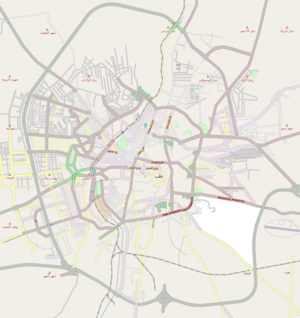Forty Martyrs Cathedral
| Cathedral of the Holy Forty Martyrs Սրբոց Քառասնից Մանկանց Մայր Եկեղեցի |
|
|---|---|

The belfry of the Forty Martyrs Cathedral
|
|
| Basic information | |
| Location |
Al-Jdayde quarter, |
| Geographic coordinates | 36°12′22″N 37°09′19″E / 36.2062°N 37.1552°ECoordinates: 36°12′22″N 37°09′19″E / 36.2062°N 37.1552°E |
| Affiliation |
Armenian Apostolic Church, Diocese of Beroea |
| Region | Aleppo |
| Year consecrated | 1491 |
| Ecclesiastical or organizational status | abandoned |
| Architectural description | |
| Architectural type | Church |
| Architectural style | three-nave basilica with no dome |
The Forty Martyrs Armenian Cathedral (Arabic: كنيسة الأربعين شهيدا) of Aleppo, Syria, is a 15th-century Armenian Apostolic church located in the old Christian quarter of Jdeydeh. It is significant among the Armenian churches for being one of the oldest active churches in the Armenian diaspora and the city of Aleppo. It is a three-nave basilica church with no dome. Its bell tower of 1912, is considered to be one of the unique samples of the baroque architecture in Aleppo.
The first significant Armenian presence in the city of Aleppo dates to the 1st century BC, when Armenia under Tigranes the Great subjugated Syria, and chose Antioch as one of the four capitals of the short lived Armenian Empire. After 301 AD, when Christianity became the official state religion of Armenia and its population, Aleppo became an important center for Armenian pilgrims on their way to Jerusalem. Yet, the Armenians did not form into an organized community in Aleppo until the Armenian presence grew noticeably during the 11th century at the times of the Armenian Kingdom of Cilicia, when a considerable number of Armenian families and merchants settled in the city creating their own businesses and residences. With the foundation of Armenian schools, churches and later on the prelacy, Armenians presented themselves as a well-organized community during the 14th century.
The Armenian population of Aleppo continued to grow as Aleppo was swallowed into the Ottoman Empire. The Ottoman Empire had a large indigenous Armenian population in its Eastern Anatolia region, from where some Armenians moved to Aleppo in search of economic opportunity. The Armenian presence in Aleppo grew exponentially after 1915, when it became an immediate haven for refugees of survivors of the Armenian Genocide. Tens of thousands of Armenian refugees, likely well over 100,000, settled in Aleppo during this period. By some estimates, Armenians accounted for a quarter of Aleppo's population by the middle of the twentieth century, by which time they had become a respected, upwardly mobile community. Later, as a result of political upheaval in Syria, Armenians began to emigrate to Lebanon and later to Europe, the Americas and Australia, especially in the 1970s and 1980s. Nonetheless, Aleppo remained a center of the worldwide Armenian diaspora, ranging between 50,000 and 70,000 Armenians residents. Tens of thousands of Armenians left during the civil war, and it remains to be seen what will remain of the community when stability returns.
...
Wikipedia

